
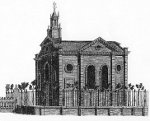
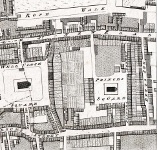
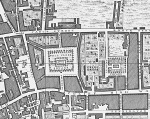 The
first Swedish congregation in London was formed in 1710. They rented an
Anabaptist chapel in Ratcliff Highway for worship, under the oversight
of
Dr. Jesper Swedberg, bishop of Skara (father of Emanuel Swedenborg). They
obtained the lease on a plot of land, 100' x 70', for their own church
in Prince's Square, paid for by King
Charles XII [right: Rocque map 1746, Horwood map 1792]. The first stone
was laid in May 1728, and the building was
consecrated the following Michaelmas, at a cost of £1204 17s. 6d. [engraving left by Bejamin Cole, c1750].
The
first Swedish congregation in London was formed in 1710. They rented an
Anabaptist chapel in Ratcliff Highway for worship, under the oversight
of
Dr. Jesper Swedberg, bishop of Skara (father of Emanuel Swedenborg). They
obtained the lease on a plot of land, 100' x 70', for their own church
in Prince's Square, paid for by King
Charles XII [right: Rocque map 1746, Horwood map 1792]. The first stone
was laid in May 1728, and the building was
consecrated the following Michaelmas, at a cost of £1204 17s. 6d. [engraving left by Bejamin Cole, c1750].

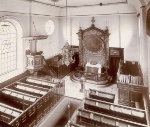
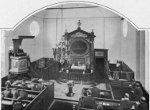 It was
opened by Queen Eleanora (1688-1741) [left], Charles' sister and successor, and
named after her - Ulrika Eleanora
Church. Built on Lutheran principles, it was a small and
plain
church, with galleries. The oval
painting over the altar was of
the Last Supper; all the woodwork was of high quality. The church was
perhaps modelled on the adjacent, and
very similar, Danish Church in Wellclose Square, but was one bay shorter. The interior is pictured right (the second photograph after the closure of the church). See further S. Evander and L. Sjöström Svenska Kyrkan i London 1710–2000: En historia i ord och bilder (London 2001).
It was
opened by Queen Eleanora (1688-1741) [left], Charles' sister and successor, and
named after her - Ulrika Eleanora
Church. Built on Lutheran principles, it was a small and
plain
church, with galleries. The oval
painting over the altar was of
the Last Supper; all the woodwork was of high quality. The church was
perhaps modelled on the adjacent, and
very similar, Danish Church in Wellclose Square, but was one bay shorter. The interior is pictured right (the second photograph after the closure of the church). See further S. Evander and L. Sjöström Svenska Kyrkan i London 1710–2000: En historia i ord och bilder (London 2001).
| When the first Swedish congregation was organising itself in London, in
1710, and desired to be under Episcopal authority, it turned to Dr.
Jesper Swedberg; partly on account of his reputation in the Church at
home for piety, learning, and zeal; partly because he was already
religious overseer of Swedish congregations in America. In a letter which Swedberg writes to them in July, 1710, he promises willing compliance with their wishes, and offers some advice, bidding them cultivate mutual affection and confidence, and Christian prudence, which he thinks particularly desirable in a foreign country, among people of all kinds of religions and opinions, adding that he would emphatically recommend that the ministers do not engage themselves too much in contentions about religion, but preach God's words in their purity, and inculcate the practical virtues. In another letter from him, 1st Aug. of the same year, he wishes, on concluding, "that God may bless them all both small and great for His Son Jesus Christ's sake". The Bishop sermonizes unsparingly in his correspondence with the Society. Specimens might be given, but they would closely resemble that printed a year or two ago in the Intellectual Repository from his volume of sermons. When his son's mission is remembered, the following expressions, written 1715, read strangely:— "It cannot but be a great joy to us that, with our countrymen, the evangelic doctrine spreads so widely, and is now preached not only in England and Portugal, but also in the great New World of America, among the heathens, where our Swedish countrymen have already three extensive congregations, each with its church and minister. Thus it seems that it is gradually being fulfilled what God promised the heathen in His Holy Word, by grace in Christ Jesus, and what Christ himself hath said, 'And the Gospel of the Kingdom shall be preached in all the world for a witness unto all nations' (Matt xxiv. 14)." In a dateless letter, which seems, however, to have been written 1715 or 1716, and addresses the king, he seeks to forward the material interests of the Society:— "Furthermore as timber is rather dear in England, it would be a notable assistance to the congregation if it graciously pleased your Majesty to permit to be felled, for the above-named purpose, on some Crown-forest situate by the sea-side, 200 pieces of timber, which are required for the preparation of the church and the erection of the steeple, that the means which would otherwise have to be expended for this object might be spared to meet other demands." The only other detail that concerns Swedenborg's father is in a determination of the Society to submit themselves to the Royal pleasure in the selection of a pastor, for they "receive a salary for him from the King, and would besides withdraw themselves from the usurped Episcopal authority." The compiler of these notices has no clew [sic] to the motive for this anti-episcopal resolution. The worthy busy Bishop seems to have taken no part in their affairs for some years before this, which took place in 1728, when the present church was built. The congregation had previously met in what had been an Anabaptist's prayer house in Ratcliff Highway. Ferelius, who gave Swedenborg the Holy Supper on his death-bed, had been co-adjutor with the preceding pastor for two years, when he was called to the pulpit in 1760. The record of such church transactions as Ferelius took part in, shows that he was a zealous and well-meaning, but a heady and precipitate person. His residence at 13, Princes Square, may be worth knowing, as Swedenborg, when in London, occasionally attended Divine service in the Swedish Church, and used after it to dine with Ferelius or some other countryman. Yet he expressed to them "that he had no peace in the Church by reason of the spirits, who gainsaid what the preacher laid down, especially when he mentioned three persons in the Divinity, which, in fact, was just like three Gods." Ferelius was promoted in 1772 to some pastorate in Sweden, which seems to have been a common manner of exit for the ministers of this chapel. On the 5th of April, in that year, Ferelius gave his farewell sermon; and this is the day too on which Swedenborg was committed to the vault. One other character is of interest in connexion with Swedenborg. This is Mathesius, who persuaded Wesley that Swedenborg was insane. Mathesius came to London 1768. In 1770 he became minister to the Danish congregation, and five months before Swedenborg's death he was made assistant to Ferelius.The irregular and unseemly management, on Mathesius's part, of Church meetings, provoked a complaint thereon addressed to the King by some indignant members of the flock, in 1777. The main grievances set forth were these:—The employment of Church money on his own authority; personalities from the pulpit; lack of order in reports and minutes; refusal of access, by members, to the Church books; that meetings were held without previous orderly summons; that reports were signed with members' names, they being ignorant thereof; that he, the pastor, went into the country without due leave; that he was the occasion of discord within the congregation, by incensing the lower classes against the higher, and persuading them they possessed privileges, in the management of Church affairs, to which they had no title; lastly, they complained of his irregularity of procedure in the purchase of a pastor's residence, &c. The authorities in Sweden directed that this statement should be laid before the accused, whose reply was to be forthcoming within a month; that he should be suspended till further notice; and that he should receive a rebuke from Envoy Baron Von Nolcken for unbecoming behaviour towards him. In his reply, Mathesius contests the assertions made, and hopes his Majesty will graciously permit him to resume his office. He subsequently aided in the promotion of those projects to which he had at first offered so active and inorderly a resistance, and, by this change of colour, regained the support of the Envoy. He was again admitted to his post. In 1785 he returned to Sweden, and died there in 1808. |
| - allegiance to the King of Sweden, so far as it does not
interfere with that to the King of England - the Swedish Ambassador to be the protector and intercessor of the congregation at the courts of London and England, and chairman of the vestries - the minister of the church to be chaplain to the embassy - the congregation to belong to the diocese of Upsal [Uppsala] - te church affairs to be governed by the minister, three trustees, and twelve churchwardens |
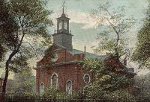 The church
served the
growing Scandinavian population who settled in the area in the years
after the Great Fire of London in 1666 – wealthy timber
merchants,
embassy staff and a growing number of sailors and shopkeepers.
It was also used by Swedish-speaking Finns. When the Danish church
closed in the early 19th century, members, and the Danish government
subsidy, were transferred here.
The church
served the
growing Scandinavian population who settled in the area in the years
after the Great Fire of London in 1666 – wealthy timber
merchants,
embassy staff and a growing number of sailors and shopkeepers.
It was also used by Swedish-speaking Finns. When the Danish church
closed in the early 19th century, members, and the Danish government
subsidy, were transferred here. | - Dr Martin Hegardt
(1710-12), afterwards Dean of Lund
in Sweden; Charles XII lived two years
in the Dean's house at Lund, and stood sponsor for one of his sons - Olaus Nordborg M.A. (1712-23) - Dr Jacob Serenius (1723-35), afterwards Bishop of Strängnäs in Sweden* [according to Daniel Lysons in The Environs of London, vol 2 (County of Middlesex), 1795, he was the author of a dictionary of the Swedish language, and his portraint hung in the vestry] - Tobias Elias Biork (1735-49) - Dr Carl Noring (1749-61) - Arvid Ferelius M.A. (1769-73) [note the comments about him above] - A(a)ron Mathesius M.A. (1773-84) [note the comments about him above] - Andreas Leufvenius (1784-90), died in London and buried in the vault of the church - Samuel Conradi Nisser M.A. (1791-1802) - Dr Gustaf Brunnmark (1802-14) - Olif Svanander (1814-15), died in Africa - Lars Christian Tunelius (1816) - Dr Johan Peter Wahlin (1818-32) - Cornelius Rahmn (1833-40) - who established an Auxiliary Missionary and Tract Society, in connection with the Missionary Society at Stockholm - Gustaf Wilhelm Carlson M.A. (1840-) [author of the notes above] |
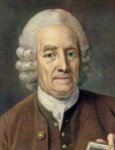
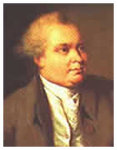 As noted above, the
scientist, mystic and philosopher Emanuel Swedenborg
(1688-1772) [left]
was
its most
famous worshipper. He had lodged locally, in Wellclose Square,
and elsewhere in London, and was buried in
its
vaults. His body lay in state at the home of Mr Birkhard, the clerk
of the Church, in Ratcliff Highway. The funeral service was conducted
by Pastor Ferelius: see below for the subsequent fate of his remains.
His followers founded The New Church, which continues to this day, with
a distinctive theological stance.
As noted above, the
scientist, mystic and philosopher Emanuel Swedenborg
(1688-1772) [left]
was
its most
famous worshipper. He had lodged locally, in Wellclose Square,
and elsewhere in London, and was buried in
its
vaults. His body lay in state at the home of Mr Birkhard, the clerk
of the Church, in Ratcliff Highway. The funeral service was conducted
by Pastor Ferelius: see below for the subsequent fate of his remains.
His followers founded The New Church, which continues to this day, with
a distinctive theological stance.| King of Sweden's Birth Day.—Nov. 1, the Swedes in London celebrated the anniversary of their sovereign's birth with great demonstrations of loyalty. Te Deum was sung in the Swedish church, in Prince's-square, and an appropriate sermon preached by the chaplain to the legation. After service the Ambassador invited a number of his counrtymen to dine, at his house in Albemarle-street, at which the healths of the Kings of Sweden and Great Britain were drank, as usual, by the company standing. The poor of the congregation had an extra allowance for the day; and the collection for the Swedish Patriotic Fund lately established in London, to give relief to the wounded Swedish soldiers, and to widows and orphans of the slain in the different engagements with the French in Pomerania. as also to the Swedish prisoners in France, was very liberal. |
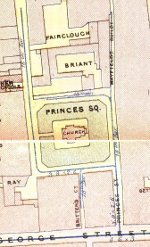 The burial ground became overcrowded, and was closed. G.A.
Walker, in Gatherings
from Graveyards, noted in 1839The
grave digger, an old Swede, narrowly escaped with his life, on two
occasions, from the falling in of the ground. There is a vault
underneath the church, which is never opened, unless for burial; the
entrance is secured by a very heavy stone slab, which, after
every funeral, is securely cemented down.
The burial ground became overcrowded, and was closed. G.A.
Walker, in Gatherings
from Graveyards, noted in 1839The
grave digger, an old Swede, narrowly escaped with his life, on two
occasions, from the falling in of the ground. There is a vault
underneath the church, which is never opened, unless for burial; the
entrance is secured by a very heavy stone slab, which, after
every funeral, is securely cemented down. Elizabeth
Stride, one of Jack the Ripper's victims, was Swedish, born in
Torslanda, a small village near Gothenburg.
At 1am on 30 September 1888 Louise Diemschutz, steward of the
International Working Men's Educational Club, was driving his pony and
cart into the yard at the junction of Fairclough and Berner [now
Henriques] Streets - a site which is now part of the playground of Harry Gosling School.
He stopped when his pony shied, and discovered a body by the gate. This
was Elizabeth Stride ('Long Liz'). Her body was less mutilated than
those of the Ripper's other victims, so perhaps he had been
disturbed. 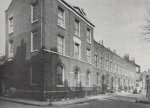 It was brought to the mortuary at St George-in-the-East,
and
the inquest held in the Vestry Hall. Sven
Olsson, the clerk of the Swedish church, who lived at 33 Prince's
Square [left - later
6 Swedenborg Gardens], and ran a reading room for Swedish seamen, knew
her and had provided her with refuge and financial support. Olsson was
born in the
village of Övraryd, and married Mathilda (Thilda) Amalia Jonasdotter in
Aguannaryd in 1866 before they came to London. One of Thilda's
half-brothers was Joel Gustaffson, later Wirling, who lived with them
in Prince's Square and was the organist of the Swedish and Danish
churches from about 1880-82. The Olssons
later returned to Sweden, settling in Osby. Stefan Rantzow, a musician
from that area, visited St George's in 2008 with
descendants
of Elizabeth Stride. Articles about their visit appeared in the Swedish
press.
It was brought to the mortuary at St George-in-the-East,
and
the inquest held in the Vestry Hall. Sven
Olsson, the clerk of the Swedish church, who lived at 33 Prince's
Square [left - later
6 Swedenborg Gardens], and ran a reading room for Swedish seamen, knew
her and had provided her with refuge and financial support. Olsson was
born in the
village of Övraryd, and married Mathilda (Thilda) Amalia Jonasdotter in
Aguannaryd in 1866 before they came to London. One of Thilda's
half-brothers was Joel Gustaffson, later Wirling, who lived with them
in Prince's Square and was the organist of the Swedish and Danish
churches from about 1880-82. The Olssons
later returned to Sweden, settling in Osby. Stefan Rantzow, a musician
from that area, visited St George's in 2008 with
descendants
of Elizabeth Stride. Articles about their visit appeared in the Swedish
press.
The pastor at that time (1887 until
his retirement in 1903) was Johannes Palmér, and he wrote several letters back home about the events, and also published 'Reminiscences' of his time in London.
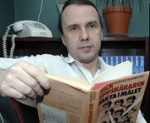 Stefan [left] has
sent us several interesting reports of his ongoing researches, in Sweden,
into the story of Elizabeth Stride's connections with the Swedish
church in London. The first relates to two of the clerk Sven Olsson's daughters. Stefan has a
distant family relationship with the Bengtsson family, and worked for a
time in the Brio publicity department, so was given a tour of the
now-empty building mentioned. The second is about documents relating to the priest and clerk of the Swedish church at that time.
Stefan [left] has
sent us several interesting reports of his ongoing researches, in Sweden,
into the story of Elizabeth Stride's connections with the Swedish
church in London. The first relates to two of the clerk Sven Olsson's daughters. Stefan has a
distant family relationship with the Bengtsson family, and worked for a
time in the Brio publicity department, so was given a tour of the
now-empty building mentioned. The second is about documents relating to the priest and clerk of the Swedish church at that time.
 Sven Olsson had four daughters, two of whom were Tekla Hilma Dagmar
Olsson, born on 18 December 1879 in London, and Regina
(Nina) Teresia Viktoria, born in London on 4 June 1882. In 1914 they started to work in a store,
named 15-Öres-Bazaren (later named Ivar Bengtssons Slöjdaffär). The
store was on the north side of a long red-painted wood
building, founded by a man named Ivar Bengtsson who also was the
founder of the famous toy factory Brio
[best known for wooden train sets - right]. In 1920 Brio gave them each 100
Swedish crowns as a Christmas bonus. In February 1936
15-Öres-Bazaren started to sell out their goods because it was decided
that the store should close. The store was demolished and a new Brio
office block built on its spot. Tekla and Regina was transfered
from 15-Öres-Bazaren to a new store, located at the bottom floor in
Brio's office block, which first opened its doors in November 1936.
(The
rest of the 15-Öres-Bazaren house was destroyed in a fire in 1943).
They worked in the Brio store until the early 1940s, and then as
homeworkers for the firm. Regina died on 22 May 1950
and Tekla on 6 July 1966.The Brio store was closed in the late 1960´s but
reopened in 2009. The Brio head office moved from Osby to Malmö in 2006;
the Osby site is now a toy museum. Sven Olsson had four daughters, two of whom were Tekla Hilma Dagmar
Olsson, born on 18 December 1879 in London, and Regina
(Nina) Teresia Viktoria, born in London on 4 June 1882. In 1914 they started to work in a store,
named 15-Öres-Bazaren (later named Ivar Bengtssons Slöjdaffär). The
store was on the north side of a long red-painted wood
building, founded by a man named Ivar Bengtsson who also was the
founder of the famous toy factory Brio
[best known for wooden train sets - right]. In 1920 Brio gave them each 100
Swedish crowns as a Christmas bonus. In February 1936
15-Öres-Bazaren started to sell out their goods because it was decided
that the store should close. The store was demolished and a new Brio
office block built on its spot. Tekla and Regina was transfered
from 15-Öres-Bazaren to a new store, located at the bottom floor in
Brio's office block, which first opened its doors in November 1936.
(The
rest of the 15-Öres-Bazaren house was destroyed in a fire in 1943).
They worked in the Brio store until the early 1940s, and then as
homeworkers for the firm. Regina died on 22 May 1950
and Tekla on 6 July 1966.The Brio store was closed in the late 1960´s but
reopened in 2009. The Brio head office moved from Osby to Malmö in 2006;
the Osby site is now a toy museum. |
| December 2014: I recently visited the archive of material from the Swedish Church in
London, which was transferred to Uppsala in 2011. It contains items
dating back to 1710, and includes all the material from 1866 when
Elizabeth Stride moved to London until her murder in 1888. Some of this
is previously unexplored, and I spent a good deal of time making
copies. From 1886 Elizabeth appears from time to time in the Fattigvårdsbok, in which the priest or clerk noted the names of poor Swedes in the East End and how much money they were given; and her last payment was ten days before her death. The archive also contains some of the private diaries of Johannes Palmér, the priest from 1887-1903, including a mention of her murder in his entry for 30 September 1888. There is also a letter written by Palmér to the clerk Sven Olsson, asking him to go down to the mortuary at St George-in-the-East to view the body and give information to the police. His diaries are written in old-style Swedish (with some expressions that have passed out of use), mixed in places with English – including roads, streets and buildings which have gone or were renamed. They give a good view of the life of the church and the poverty that surrounded it. In one letter he wrote to the chief of Scotland Yard saying that he must place more policemen around the church because the poor were stealing from it. He found the beggars irritating, and in another letter calls them 'parasites'. There are also notes of visits by several Swedish royals; preaching at the Crystal Palace; and at the end of 1888 a request to the clerk Sven Olsson to light all the candles and gas lamps in the church because the nights were very foggy. Palmér was frequently in contact with the famous Dr Thomas Barnardo, discussing the situation of poor and sick people in the East End. In 1894 Johannes Palmér came into conflict (unspecified) with his clerk, and in a letter to Axel Welin, a Swedish inventor and industrialist, he said that he was going to leave the church. Several other letters were written by Sven Olsson, complaining that he had to use his own money to buy soap and cleaning materials for the church, the windows of which were very dirty. He was sometimes paid by the church in coal, used for heating both the church and the reading room located in his house at 33 Princes Square; his sense of frustration about this is very apparent! Another paper, containing many names, declared their support for him, and gave assurance that if he left the church they would provide a lifetime pension, because he had small children at home. But does this relate to the conflict with Palmér? |
|
July 2015: Stefan arranged a meeting with the Jacobson brothers and Sally and John Edmonds – Sally is related to John Thomas Stride, the carpenter from Sheerness who married Elizabeth Stride in London in 1869. Joined by local historians and representatives of the newspaper Torslanda Tidningen, they visited sites in Gothenberg, starting at the church where Elizabeth was baptized (and her parents Gustaf Ericsson and Beata Carlsdotter were buried: their graves are gone, but the grave of the priest who baptized her, Carl Gustaf Schoug, is still there). They visited the house nearby in Stora Tumlehed where she was born – currently vacant but they had access to the keys – and then the Haga area in Gothenberg where she lived: in Pilgatan, where in 1865 she was registered by the police as 'Female Prostitute number 97', and Husargatan where she worked as a maid from November 1865 to February 1866, though this area was extensively redeveloped in the 1960s and 70s (despite protests), as was the Majorna area where she had previously worked. Stefan later visited this area and located the site of the house on which there is now a playground and pre-school. |
Prince's Square in its heyday and its demise [remaned Swedenborg Square in 1938] -
the last days of the church
An advertisement in the Public Ledger for 1761 read
| RUN AWAY FROM CAPTAIN STUBBS. Yellowish Negro Man, about Five Feet Seven Inches, a very flat Nose, and a Scar above his Forehead, he had when he run away, a white Pea-Jacket, a pair of black Worsted Stockings, and a black Wig. Whoever will bring the said Negro Man to his above-mentioned Master, Capt. Stubbs in Prince's Square, Ratcliffe-highway, shall receive Two Guineas Reward. |
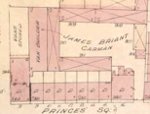 The Briant cabmans' yard on the north side of the square had a long history. In 1794 Richard and James Briant, wharfingers
of 51 Lower East Smithfield, insured this and other properties. Their
parnership ended two years later, each continuing separately in
business. In 1812, Richard Potter
was sentenced to a public whipping near to Chester's Quay for the theft
of a 'head of hemp' (14lb 14oz, value 13 or 14 shillings) which he had
separated from the main load in one of their wagons and concealed on
its tilt; he offered no defence. James, described as a gentleman,
insured property in Regent Street, Mile End, in the 1820s, but in 1846
his will was proved in London Diocesan Consistory Court, and the
following year that of his widow Elizabeth, both of 34 Prince's Square
- indicating that they had considerable property. Directories of that
decade refer to Richard Wippell Briant, carman, of 41 or 42 Princes Square and also at London Dock, and Robert Frederick Briant, wheelwright, of the same address. Goad's insurance map of 1899 [right] shows that their premises remained, on the north side of the square.
The Briant cabmans' yard on the north side of the square had a long history. In 1794 Richard and James Briant, wharfingers
of 51 Lower East Smithfield, insured this and other properties. Their
parnership ended two years later, each continuing separately in
business. In 1812, Richard Potter
was sentenced to a public whipping near to Chester's Quay for the theft
of a 'head of hemp' (14lb 14oz, value 13 or 14 shillings) which he had
separated from the main load in one of their wagons and concealed on
its tilt; he offered no defence. James, described as a gentleman,
insured property in Regent Street, Mile End, in the 1820s, but in 1846
his will was proved in London Diocesan Consistory Court, and the
following year that of his widow Elizabeth, both of 34 Prince's Square
- indicating that they had considerable property. Directories of that
decade refer to Richard Wippell Briant, carman, of 41 or 42 Princes Square and also at London Dock, and Robert Frederick Briant, wheelwright, of the same address. Goad's insurance map of 1899 [right] shows that their premises remained, on the north side of the square.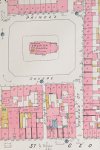 As elsewhere in the area, housing developed check-by-jowl
with workshops and a range of institutions. Among them in its latter years was the Judean School & Athletic (Temperance)
Club,
founded in the early 20th century by the brothers Dave and Barney
Sticher in a stable loft at no.74 (later 54-56), where a number of
Jewish boxers trained and made their debut - see here
for more details. According to the police inspector who reported on
this patch for the 1896 Booth survey [digitised image of the page here], Mayfield Buildings, accessed from the NW corner of the square and running up to Cable Street, was The
worst place in the subdivision, not a male in the street above school
age that has not been convicted. Thieves, prostitutes, rough Cockney
Irish. Broken dirty windows. Bareheaded women. Doors open, black shiny
doorposts, 3-storied houses. 'Has been the ruin of Princes Square, a quiet country-like
place.' It was not, however, marked black on the map (the 'most
vicious' category), and his assessment is at odds with records of the
time which show the tenants to be the 'working poor': see this
site, a fascinating account of the life of a German street musician's
family, for full details. Right is Goad's insurance map of 1887 showing the Square, with Prince's Street and Britten's Court leading into it from St George's Street.
As elsewhere in the area, housing developed check-by-jowl
with workshops and a range of institutions. Among them in its latter years was the Judean School & Athletic (Temperance)
Club,
founded in the early 20th century by the brothers Dave and Barney
Sticher in a stable loft at no.74 (later 54-56), where a number of
Jewish boxers trained and made their debut - see here
for more details. According to the police inspector who reported on
this patch for the 1896 Booth survey [digitised image of the page here], Mayfield Buildings, accessed from the NW corner of the square and running up to Cable Street, was The
worst place in the subdivision, not a male in the street above school
age that has not been convicted. Thieves, prostitutes, rough Cockney
Irish. Broken dirty windows. Bareheaded women. Doors open, black shiny
doorposts, 3-storied houses. 'Has been the ruin of Princes Square, a quiet country-like
place.' It was not, however, marked black on the map (the 'most
vicious' category), and his assessment is at odds with records of the
time which show the tenants to be the 'working poor': see this
site, a fascinating account of the life of a German street musician's
family, for full details. Right is Goad's insurance map of 1887 showing the Square, with Prince's Street and Britten's Court leading into it from St George's Street.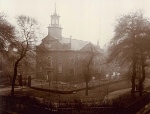
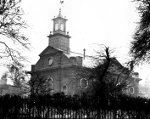

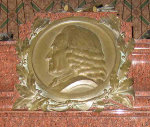
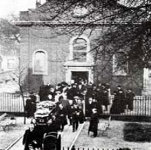 When
the timber trade moved south of the river to Surrey Docks, in the
latter part of the 19th century, the church went into decline. The 1888
Religious Census of London records its Sunday morning attendance as 61 (and its minister as the Revd A.R. Frost). The
Swedish Seamen's Church in Lower Road, Rotherhithe opened in 1899. Closure of the Prince's Square church was mooted in 1908 [left in that year, and in 1910]. The Swedish
Government sent the
warship Fylgia to collect Swedenborg's remains [right, leaving the church], which were
reburied in a pink granite sarcophagus in Uppsala Cathedral (except, legend says, for his
skull, which a sailor stole). The church closed in 1911 and
the congregation moved to a new building in Harcourt Street, Marylebone - below], taking most of the contents.
When
the timber trade moved south of the river to Surrey Docks, in the
latter part of the 19th century, the church went into decline. The 1888
Religious Census of London records its Sunday morning attendance as 61 (and its minister as the Revd A.R. Frost). The
Swedish Seamen's Church in Lower Road, Rotherhithe opened in 1899. Closure of the Prince's Square church was mooted in 1908 [left in that year, and in 1910]. The Swedish
Government sent the
warship Fylgia to collect Swedenborg's remains [right, leaving the church], which were
reburied in a pink granite sarcophagus in Uppsala Cathedral (except, legend says, for his
skull, which a sailor stole). The church closed in 1911 and
the congregation moved to a new building in Harcourt Street, Marylebone - below], taking most of the contents.
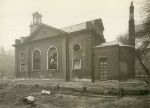
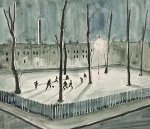
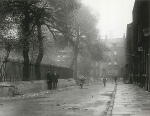
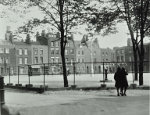 The
trustees offered the building for sale, but there were no takers. There
was a campaign to save the building and develop the land as a
children's playground. In 1917 the MP for Limehouse, Sir William
Pearce, said I
am anxious for the success of the endeavour to save the Swedish Church.
The building has much dignity and artistic merit and will be useful as
a museum for the local assembly. The open space round the church is
simply invaluable as a playground in a densely crowded neighbourhood of
very poor people. London County Council was willing to
take on the grounds, but not the
building. It deteriorated rapidly [left 1919 - and looking north 1921], and was
demolished in 1921. The LCC bought
the site in 1923
for £3,000, for the Metropolitan Gardens Association to create a public
garden, but it fell into decline. Yet it was a potentially pleasant
environment, as suggested by the 1930 photograph and the 1932 drawing, in pen and black ink with blue and green ink wash, by William Gaunt (1900-80) [both right].
The
trustees offered the building for sale, but there were no takers. There
was a campaign to save the building and develop the land as a
children's playground. In 1917 the MP for Limehouse, Sir William
Pearce, said I
am anxious for the success of the endeavour to save the Swedish Church.
The building has much dignity and artistic merit and will be useful as
a museum for the local assembly. The open space round the church is
simply invaluable as a playground in a densely crowded neighbourhood of
very poor people. London County Council was willing to
take on the grounds, but not the
building. It deteriorated rapidly [left 1919 - and looking north 1921], and was
demolished in 1921. The LCC bought
the site in 1923
for £3,000, for the Metropolitan Gardens Association to create a public
garden, but it fell into decline. Yet it was a potentially pleasant
environment, as suggested by the 1930 photograph and the 1932 drawing, in pen and black ink with blue and green ink wash, by William Gaunt (1900-80) [both right].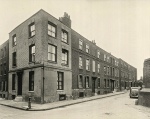
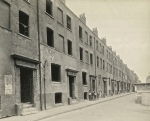
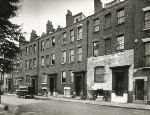
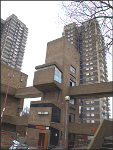
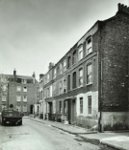 The Blitz claimed more of the houses [left: south
and west sides of the square in 1945, and two 1961 views, the second
looking towards Britten's Court], but others stood until the 1960s
when slum clearance claimed the rest, and St George's Estate [right] was
created in the1960's - a fuller account of the loss of the square and the building of the estate is given here.
The Blitz claimed more of the houses [left: south
and west sides of the square in 1945, and two 1961 views, the second
looking towards Britten's Court], but others stood until the 1960s
when slum clearance claimed the rest, and St George's Estate [right] was
created in the1960's - a fuller account of the loss of the square and the building of the estate is given here.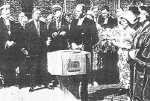
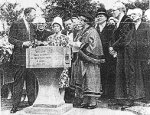
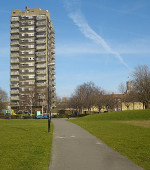
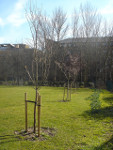
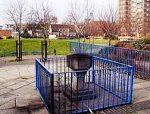 The historic links
survive
only in the names
'Swedenborg Gardens' [two views left] and 'Solander Gardens', plus the siting of the
font from the Swedish Church, which was placed in the park on 18 June
1960 [right] and dedicated to
commemorate the site of the church and the 250th anniversary of the
Swedish congregation in London. Pictures of this event show HRH
Prince
Bertil handing over the memorial to the Mayor of Stepney, Mrs A. Elboz.
A nearby plaque
also
commemorates the anniversary. The surrounding area was re-landscaped,
with recreational areas, a children's playground, and paths and
fencing, at a cost of £160,000 by Wapping Neighbourhood.The unusual
angle of the rear wall of the
Texaco petrol station probably marks the original geography of the
square. More recently, in the area east of the font some inscriptions
commemorating Swedenborg and Solander have been added at the base of
the trees.
The historic links
survive
only in the names
'Swedenborg Gardens' [two views left] and 'Solander Gardens', plus the siting of the
font from the Swedish Church, which was placed in the park on 18 June
1960 [right] and dedicated to
commemorate the site of the church and the 250th anniversary of the
Swedish congregation in London. Pictures of this event show HRH
Prince
Bertil handing over the memorial to the Mayor of Stepney, Mrs A. Elboz.
A nearby plaque
also
commemorates the anniversary. The surrounding area was re-landscaped,
with recreational areas, a children's playground, and paths and
fencing, at a cost of £160,000 by Wapping Neighbourhood.The unusual
angle of the rear wall of the
Texaco petrol station probably marks the original geography of the
square. More recently, in the area east of the font some inscriptions
commemorating Swedenborg and Solander have been added at the base of
the trees.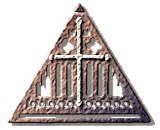 Porvoo
Porvoo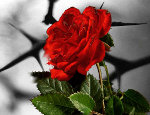

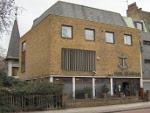 The
two Swedish churches in London - at Harcourt Street, Marylebone - now Grade II listed [first left], and
the Swedish Seamen's Church and hostel in Rotherhithe [1899, rebuilt 1930 and remodelled 1966 - second left] work together
as part of Svenska Kyrkan i Utlandet (SKUT), the Swedish Church Abroad,
under the oversight of the Bishop of Visby. They also hold occasional services in Icelandic (the Evangelical Lutheran Church of Iceland is a fellow-Porvoo church). The parish motto remains rosa inter spinas - a rose among thorns: a phrase widely used in other contexts, and originating in a Marian antiphon, Just
as the rose amongst thorns adds beauty to them, so the Virgin Mary
adorns her offspring, for she brings forth a flower that gives a
life-saving fragrance.
The
two Swedish churches in London - at Harcourt Street, Marylebone - now Grade II listed [first left], and
the Swedish Seamen's Church and hostel in Rotherhithe [1899, rebuilt 1930 and remodelled 1966 - second left] work together
as part of Svenska Kyrkan i Utlandet (SKUT), the Swedish Church Abroad,
under the oversight of the Bishop of Visby. They also hold occasional services in Icelandic (the Evangelical Lutheran Church of Iceland is a fellow-Porvoo church). The parish motto remains rosa inter spinas - a rose among thorns: a phrase widely used in other contexts, and originating in a Marian antiphon, Just
as the rose amongst thorns adds beauty to them, so the Virgin Mary
adorns her offspring, for she brings forth a flower that gives a
life-saving fragrance.